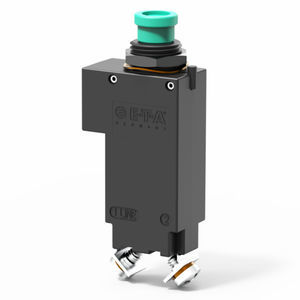
Thermal aerospace circuit breaker 482 seriesmanual3-polecompact
Add to favorites
Compare this product
Characteristics
- Type
- thermal
- Operating mode
- manual
- Number of poles
- 3-pole
- Other characteristics
- compact, high-performance
- Primary current
Min.: 0.1 A
Max.: 50 A
- VAC
115 V, 230 V
- VDC
28 V
Description
Single pole compact high performance thermal circuit breaker with tease-free, trip-free, snap action mechanism and push/pull on/off manual actuation (M-type TO CBE to EN 60934). An indicator band on the push button clearly shows the tripped/off position. Threadneck panel mounted in tracked vehicle and aircraft/general purpose versions, with optional auxiliary contacts.
Mounting method - socket
threadneck
Terminal design - blade terminals
screw terminals
Actuation - manual release
push button
Auxiliary contacts - with auxiliary contacts
without auxiliary contacts
Water splash protection - with water splash protection
without water splash protection
Illumination - without illumination
Typical life - 10,000 operations mechanical
5,000 operations at IN
Certificates - VG 95345 part 21, QPL Canada, UL, CSA
ACCESSORIES
Order number - Description -
X20080103 -
splash cover black with O-ring
X20080108 -
splash cover transparent with O-ring
X20080201 -
splash cover black with O-ring,
nickel plated nut
X20080202 -
splash cover black with O-ring,
matt black finish nut
X20080301 -
actuator extension
Y30700401-05 -
identification collar
Y30700501 -
lock out ring
APPLICATIONS
Aerospace
Automation
Automobiles
Commercial Vehicles
Rail vehicles
Telecom & Datacom
Watercraft & Vehicles
Catalogs
No catalogs are available for this product.
See all of E-T-A‘s catalogs*Prices are pre-tax. They exclude delivery charges and customs duties and do not include additional charges for installation or activation options. Prices are indicative only and may vary by country, with changes to the cost of raw materials and exchange rates.






